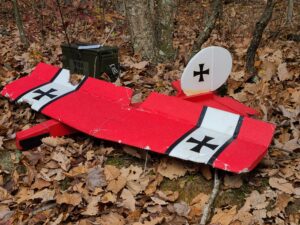On November 4th the Nittany Amateur Radio Club (NARC) sponsored a foxhunt that provided a drill simulating the search for a downed airplane. Woody, K3YV, put the idea together to use as part of the SET exercises on October 7th. Unfortunately weather canceled the event for that day. It was rescheduled for November 4th.
The scenario for the exercise was:
There is a replica WWI military aircraft that has disappeared enroute from Scranton, PA to Dayton, OH. The WWI airplane was to take part in an air show at the Wright Patterson Airforce Base. Radar and radio contact were lost somewhere over the State College region. The FAA reports that the emergency transponder seems to be nonfunctional, and may have been knocked off frequency in the crash. So far, the Civil Air Patrol has reported hearing a faint signal that was going off and on and beeping. They reported it was drifting in frequency, and they eventually lost track of the signal. The FAA and Civil Air Patrol have requested assistance from radio amateurs to help track down the missing aircraft by locating the missing signal frequency and tracking it to the downed aircraft location. It is thought that the emergency transponder could be anywhere in the VHF radio band and may, in fact, be on an amateur radio two-meter simplex frequency.
Radio Amateurs are requested to organize into groups or go as individuals and try to determine the frequency of the on/off beeping transponder. Once the signal is obtained, hams are requested to locate the aircraft crash sight. This of course will require tuning around the VHF ham bands until the signal is heard. Then use direction finding techniques to locate the crash site. The goal of the foxhunt is to determine the frequency, locate the crash site, find out the number of survivors, and find out the physical description of the type and color of the airplane. There will be a tag on the transmitter box indicating the number of crash survivors, and there will be a crashed model airplane located next to the radio transmitter.
Rules for the foxhunt were:
1. The foxhunt transmitter will go on the air at 10:00 AM.
2. The transmitter will be on a two-meter simplex frequency.
3. There will be a crashed model airplane located next to the radio transmitter.
4. There will be a tag on the transmitter box indicating the number of crash survivors and the type of airplane.
5. The goal of the foxhunt is to determine the transponder frequency, locate the crash site, find out the number of survivors, the type of airplane, and the color of the airplane.
6. At 11:00 AM the frequency of the foxhunt transmitter will be announced on the 85 repeater.
7. The foxhunt will end at 2:00 PM unless hunters request further time.
8. The approximate boundaries for the foxhunt are south of Bellefonte, north of Pine Grove Mills, east of Port Matilda, and west of Centre Hall.
9. Headquarters will be on the 85 repeater to offer assistance and offer hints.
10. The foxhunt scenario is a downed aircraft in the State College region with an off-frequency emergency radio transponder.
11. Please take photos of you or your group with your foxhunting gear and/or of you at the crash site. We would all love to see you and your success.
Five field teams participated and found the simulated crash within 2.5 hours. That included time to find the frequency the beacon was operating on. The teams were:
